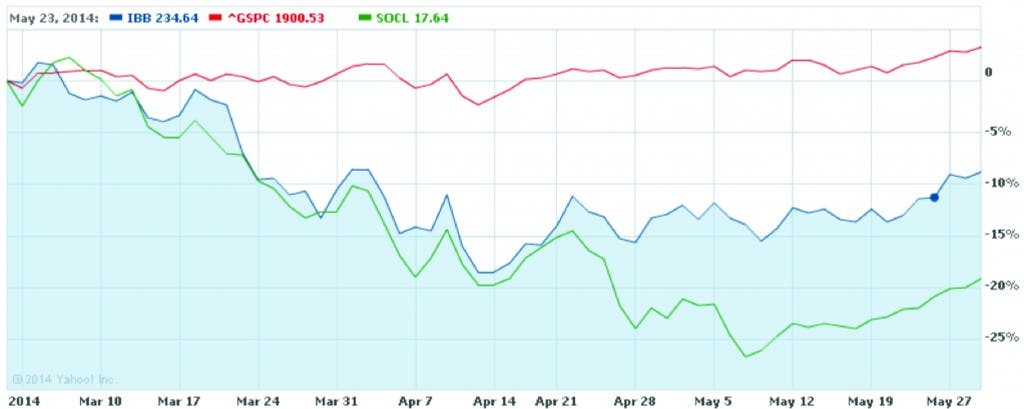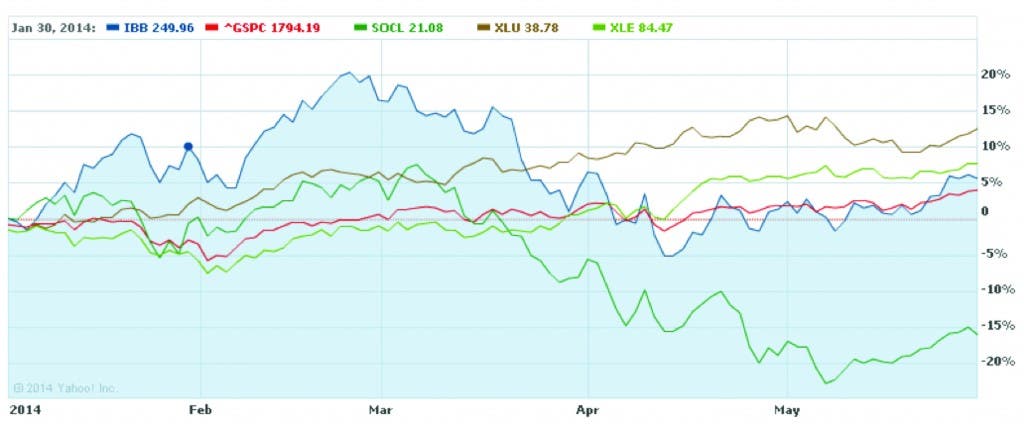By: Jim Edwards | CFP® – Financial Advisor and Portfolio Manager
The stock market can be compared to an ocean with individual companies representing boats traveling on its seas. There are times when certain parts of this ocean are choppier than others. In the first half of this year, for example, there wasn’t much movement in the broader market (the ocean surface). At the same time, however, there has been a lot of movement beneath the surface.
Sector rotation, the shifting of money from one sector of the economy to another, can be illustrated by comparing the recent performance of biotech, social media, energy, and utility companies. In 2013, biotechnology and social media stocks experienced an extraordinary rally, and were up approximately 60% at the end of the year. The rally continued into 2014, but from late February to early May these stocks fell more than 20%, while the S&P achieved modest gains. (Source: Yahoo! Finance)
RED — GSPC: S&P 500 Index GREEN — SOCL: Global X Social Media Index ETF BLUE — IBB: iShares NASDAQ Biotechnology ETF
The one characteristic that both biotech and social media stocks had in common was their relative valuation. From a price-to-earnings perspective, both groups were trading at very expensive levels. Additionally, both of these industries have been popular because they are commonly characterized as “growth” industries. Growth companies are ones that are generally expected to grow at a faster rate than older, more mature businesses.
Other industry groups that were not riding the large swells in the latter half of 2013 were still trading at levels that could be considered fairly valued or, in some cases, even at a discount.
For example, in 2013, utility and energy stocks appreciated by approximately 7% and 21%, respectively. This performance was a far cry from the extraordinary returns (+60%) cited above. Nonetheless, through May 2014, utilities (+12%) and energy (+6%) had outperformed most other sectors. When we compare the performance of all these industries, the contrast is clear. (Source: Yahoo! Finance)
RED — GSPC: S&P 500 Index BLUE — IBB: iShares NASDAQ Biotechnology ETF
GREEN — SOCL: Global X Social Media Index ETF BROWN — XLU: SPDR Utility ETF
LIME GREEN — XLE: SPDR Energy ETF
One explanation for why Energy and Utility stocks are out performing the market while Biotech and Social Media stocks are under-performing is that money has flowed out of relatively “expensive” stocks and into relatively “cheap” stocks. Put another way, investors, as a whole, have been seeking out more “value.”
There may be several reasons for the notable rotation from a growth to a value orientation in stock selection. First, after a very strong 2013, money managers may be taking some profits and re-allocating funds toward more conservative and relatively inexpensive sectors. Second, many of the “cheaper” sectors are more cyclical in nature. If there is indeed a stronger economy this year, sectors such as energy and materials would likely benefit.
Beyond valuation, there are other factors that have called investor confidence into question. It may be that last year’s strong market returns reflected hopeful expectations that this year’s earnings would also be robust, as the economic recovery began to accelerate. At the beginning of the year, most economic forecasts reflected this notion. Additionally, geopolitical concerns in South America, Europe, and Asia have constantly been in 2014’s headlines. The unusually cold and long winter across the US also clearly affected first-quarter economic activity. The latest estimate from the Bureau of Economic Analysis indicates that the US economy shrank during the first quarter. This represents the first quarterly contraction since 2011.
At times, the pace of the market’s growth exceeds the rate of change in the underlying fundamentals. When this happens, corporate earnings ultimately need to grow enough (or catch up) to support the underlying change in the market’s valuation. Otherwise the market will fall, to reflect the slower rate of growth. In this environment, if a company reports disappointing earnings or issues lackluster guidance, its shares are likely to decline.
Sector rotation is a phenomenon that occurs regularly in the stock market. There can be a “sea-change” at any moment in the markets. Currently, the market is in a wait-and-see state. For the five-year rally to continue, it will likely require clear signs that the pace of corporate earnings growth is accelerating and that broader economic growth is intact. Having a disciplined and diversified investment approach better positions us to weather the storms and to sail on when the wind is at our backs.




